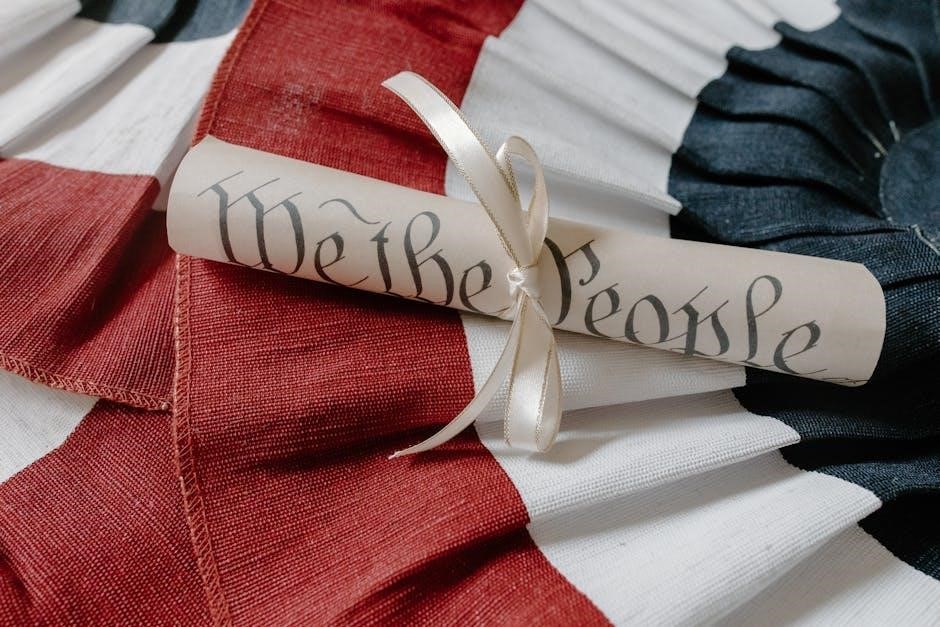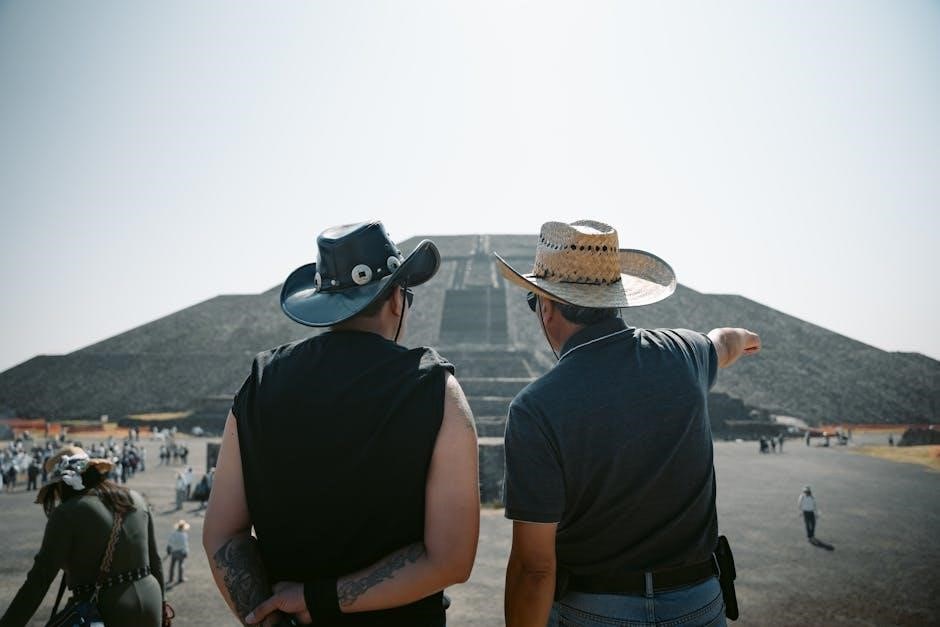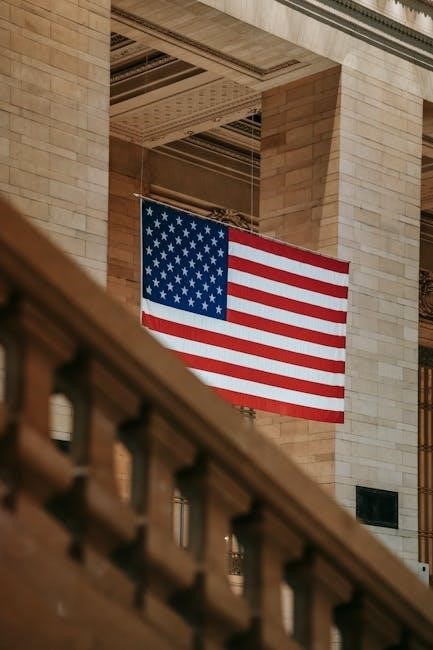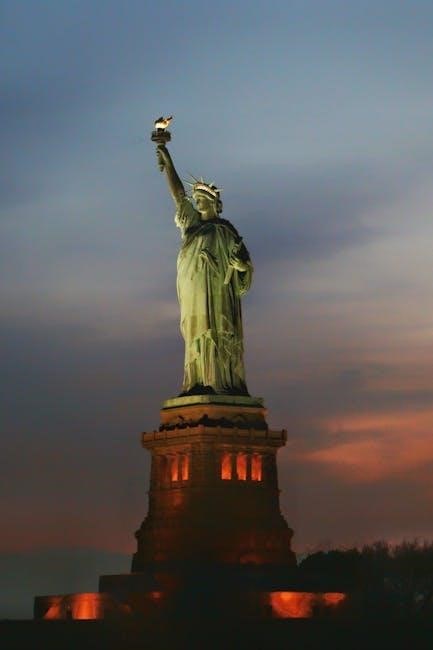us history guiding questions

Exploring US history through guiding questions helps uncover key themes‚ events‚ and ideas. These questions enable deeper analysis of historical periods‚ cultural shifts‚ and political developments. By examining primary sources‚ essays‚ and expert insights‚ learners gain a comprehensive understanding of America’s past and its impact on the present. Practice questions and study resources‚ like flashcards and textbooks‚ further enhance preparation and knowledge retention‚ making history accessible and engaging for all.
What are the key themes in US history?
Key themes in US history include freedom‚ democracy‚ self-governance‚ and the pursuit of equality. These ideas shaped the nation’s identity and development. Themes like diversity‚ immigration‚ and westward expansion highlight America’s cultural and geographic growth. Economic transformations‚ such as industrialization and technological progress‚ also played a significant role. Additionally‚ the struggle for civil rights and the impact of global conflicts have profoundly influenced the nation’s trajectory. These themes provide a framework for understanding the complexities of American history and its ongoing evolution.
How do guiding questions help in understanding US history?
Guiding questions provide a structured approach to studying US history‚ encouraging critical thinking and focused analysis. They help identify key themes‚ events‚ and ideas‚ making complex topics more manageable. By exploring these questions‚ learners can connect historical events to broader concepts‚ such as democracy‚ freedom‚ and cultural identity. Resources like primary sources‚ essays‚ and practice questions further enhance understanding‚ allowing students to engage deeply with the material and prepare effectively for assessments. This method fosters a deeper appreciation of America’s past and its ongoing impact;
What are the most important events in US history?
The most important events in US history include the American Revolution‚ the Civil War‚ the Industrial Revolution‚ World War I and II‚ the Great Depression‚ and the Civil Rights Movement. These events shaped the nation’s political‚ social‚ and economic landscape. The American Revolution established independence‚ while the Civil War addressed slavery and unity. The Industrial Revolution transformed the economy‚ and World Wars showcased US global influence. The Great Depression and Civil Rights Movement highlighted resilience and the fight for equality. Studying these events provides insights into America’s development and identity.

Colonial Era and Revolution
Guiding questions explore European colonization motivations‚ differences among the 13 colonies‚ and the Revolution’s causes. They highlight the Declaration of Independence’s role in shaping America’s identity and principles‚ using primary sources and practice questions to deepen understanding of this foundational period.
What motivated European colonization of the Americas?
Economic opportunities‚ religious freedom‚ and political ambitions drove European colonization. Nations sought wealth through trade‚ resources‚ and new markets. Religious groups aimed to escape persecution and spread Christianity. The desire for territorial expansion and strategic advantage also fueled exploration. Additionally‚ the promise of land and adventure attracted settlers. These motivations shaped the diverse settlement patterns and cultural influences across the colonies‚ laying the foundation for future societal structures and conflicts.
How did the 13 colonies differ from one another?
The 13 colonies differed in geography‚ economy‚ culture‚ and government. New England colonies focused on trade and shipping‚ while Southern colonies relied on agriculture and plantations. Middle colonies balanced agriculture and trade. Religious beliefs varied‚ with Puritan influences in Massachusetts and Quaker values in Pennsylvania. Economic systems also diverged‚ as some colonies depended on enslaved labor‚ while others emphasized small-scale farming. These differences shaped distinct regional identities and laid the foundation for future cultural and political diversity in the United States;
What were the main causes of the American Revolution?
The American Revolution was primarily driven by colonial resistance to British taxation policies‚ such as the Stamp Act and Tea Act‚ which lacked colonial representation. Enlightenment ideas emphasizing liberty and self-governance further fueled discontent. Restrictions on westward expansion and growing tensions over British rule also contributed. These factors culminated in the colonies’ desire for independence‚ leading to the outbreak of the Revolution in 1775. Understanding these causes provides insight into the birth of the United States and its foundational principles of freedom and democracy.
How did the Declaration of Independence shape US history?
The Declaration of Independence‚ adopted in 1776‚ announced the 13 colonies’ separation from Britain‚ establishing the United States as a sovereign nation. It articulated foundational principles of equality‚ liberty‚ and individual rights‚ shaping American identity. This document inspired future movements‚ including abolitionism and women’s suffrage‚ and influenced the creation of the Constitution and Bill of Rights. Its ideals continue to resonate‚ forming the bedrock of American democracy and inspiring similar declarations worldwide‚ cementing its legacy as a pivotal moment in US and global history.

Early National Period
The early national period posed challenges like establishing government stability and unity. The Constitution and Bill of Rights laid foundational principles‚ while westward expansion sparked growth and debate‚ shaping America’s future direction and identity through key events and decisions.
What were the challenges of the newly independent nation?
The newly independent nation faced significant challenges‚ including establishing a stable government‚ resolving economic struggles‚ and defining national identity. Creating a unified system under the Constitution required balancing federal and state powers. Economic difficulties‚ such as debt from the Revolutionary War‚ posed immediate threats. Additionally‚ the young nation had to assert its sovereignty internationally while addressing internal conflicts over land and rights. These challenges shaped the foundation of the United States and its future development‚ as outlined in primary sources and historical analyses.
How did the Constitution establish the framework of government?
The Constitution established a federal system with three branches: legislative‚ executive‚ and judicial. It divided powers between the federal government and states‚ ensuring checks and balances. The document outlined the structure‚ responsibilities‚ and limits of each branch‚ promoting accountability and preventing tyranny. It also guaranteed individual rights through the Bill of Rights‚ fostering liberty and representation. This framework has endured‚ shaping the foundation of American democracy and governance.
What were the key principles of the Bill of Rights?
The Bill of Rights‚ comprising the first ten amendments to the US Constitution‚ establishes fundamental liberties and protections for individuals. Key principles include freedom of speech‚ religion‚ and the press‚ as well as the right to bear arms and assemble peacefully. It safeguards against unreasonable searches and seizures‚ ensures due process‚ and protects citizens from excessive bail and punishment. These principles aim to limit government power and ensure individual rights‚ forming the cornerstone of American democracy and civil liberties.
How did westward expansion impact the young nation?
Westward expansion significantly shaped the young nation by fostering territorial growth‚ economic opportunities‚ and cultural exchange. It led to the acquisition of vast lands‚ stimulating agriculture‚ trade‚ and infrastructure development. However‚ it also sparked conflicts with Native American tribes‚ displacement‚ and environmental challenges. The expansion tested the nation’s unity‚ as sectional tensions arose over issues like slavery in new territories. Ultimately‚ it laid the foundation for the US to become a continental power‚ influencing its identity‚ economy‚ and political landscape for centuries to come.
Civil War and Reconstruction
The Civil War and Reconstruction era explored through guiding questions reveals the conflict’s causes‚ the Emancipation Proclamation’s impact‚ and Reconstruction’s lasting effects on American society and rights.
What were the primary causes of the Civil War?
The Civil War was primarily caused by deep divisions over states’ rights‚ economic differences‚ and slavery. Southern states relied on agriculture and slavery‚ while the North was industrialized and opposed slavery. The debate over slavery’s expansion and states’ rights to govern themselves led to tensions. The Kansas-Nebraska Act and Dred Scott decision intensified these conflicts. Ultimately‚ the South’s secession and formation of the Confederacy prompted the war‚ as the North sought to preserve the Union and end slavery‚ while the South fought for independence and the right to maintain its institutions.
How did the Emancipation Proclamation change the war’s purpose?
The Emancipation Proclamation‚ issued in 1863‚ reframed the Civil War’s objective from preserving the Union to also fighting for the abolition of slavery. It declared freedom for enslaved people in Confederate states‚ shifting the war’s moral purpose. This change garnered support from abolitionists and foreign nations‚ aligning the Union’s cause with universal human rights. The Proclamation also laid the groundwork for the eventual abolition of slavery through the 13th Amendment‚ transforming the war into a fight for freedom and equality.

What were the Reconstruction Amendments?
The Reconstruction Amendments‚ comprising the 13th‚ 14th‚ and 15th Amendments‚ aimed to redefine citizenship and equality after the Civil War. The 13th Amendment abolished slavery‚ while the 14th established citizenship for African Americans and ensured equal protection under the law. The 15th Amendment granted voting rights to African American men‚ regardless of race. Together‚ these amendments laid the legal groundwork for civil rights‚ reshaping the nation’s commitment to freedom and equality‚ though their full realization would take decades of struggle and further legislation.
How did Reconstruction shape the post-war South?
Reconstruction aimed to rebuild the South and integrate freed slaves into society. The 13th‚ 14th‚ and 15th Amendments abolished slavery‚ granted citizenship‚ and secured voting rights for Black men. However‚ challenges like sharecropping‚ Jim Crow laws‚ and white supremacist groups undermined progress. The Freedmen’s Bureau provided aid‚ but its impact was limited. By 1877‚ Reconstruction ended with the Compromise‚ leading to a segregated South. Despite setbacks‚ it laid the groundwork for future civil rights efforts‚ shaping the region’s social and political landscape for decades to come.

Industrialization and Immigration
Industrialization and immigration reshaped America‚ fostering economic growth and cultural diversity; Labor movements emerged‚ addressing worker rights‚ while urbanization transformed daily life‚ laying the foundation for modern challenges.

What were the major effects of industrialization on society?
Industrialization transformed society by boosting economic growth‚ creating urban centers‚ and fostering technological innovation. It led to the development of factories‚ mass production‚ and new industries‚ reshaping labor dynamics. While it improved living standards for some‚ it also caused urban overcrowding‚ poor working conditions‚ and environmental degradation. Immigration and migration increased as people sought factory jobs‚ diversifying cultures but also intensifying social tensions. Labor movements emerged to address worker exploitation‚ leading to reforms and improved rights. Overall‚ industrialization laid the foundation for modern society but introduced significant social and economic challenges.
How did immigration shape American culture and economy?
Immigration profoundly shaped American culture by introducing diverse languages‚ traditions‚ and cuisines‚ creating a multicultural society. Economically‚ immigrants provided labor for industries like manufacturing and agriculture‚ fueling growth. Their contributions also spurred urbanization‚ as cities grew with immigrant communities. However‚ immigration posed challenges‚ including discrimination and cultural clashes. Despite these issues‚ it remains a cornerstone of American identity‚ fostering innovation and cultural richness while building the nation’s economic foundation.
What were the key labor movements of the time?
The late 19th and early 20th centuries saw significant labor movements‚ driven by industrialization and worker exploitation. The Knights of Labor and the American Federation of Labor (AFL) emerged as prominent unions‚ advocating for better wages‚ shorter hours‚ and improved working conditions. Strikes like the Lawrence Textile Strike and the Pullman Strike highlighted labor struggles. The New Deal era introduced landmark legislation‚ such as the Wagner Act and the Fair Labor Standards Act‚ which protected workers’ rights and established minimum wage standards‚ reshaping the labor landscape and empowering workers nationwide.
How did urbanization transform American life?
Urbanization profoundly reshaped American life by driving economic growth and cultural diversity. Cities became hubs for industrial jobs‚ attracting immigrants and migrants. This led to the rise of a consumer economy and modern infrastructure. However‚ urbanization also brought challenges like overcrowding‚ poverty‚ and social inequality. Over time‚ reforms addressed these issues‚ improving living conditions and public services. Urban centers became focal points for innovation‚ politics‚ and social change‚ forever altering the nation’s identity and development.

World Wars and the Great Depression
The 20th century saw the US emerge as a global power through World Wars I and II‚ while the Great Depression tested societal resilience and economic systems.
What was the US role in World War I?
The United States initially maintained neutrality in World War I‚ focusing on economic ties with both sides; However‚ Germany’s unrestricted submarine warfare and the sinking of the Lusitania shifted public opinion. The Zimmermann Telegram‚ attempting to ally Mexico against the US‚ further pushed America into war. The US entered in 1917‚ contributing troops‚ supplies‚ and financial support. Its involvement was crucial in turning the tide for the Allies. The war marked the US’s emergence as a global power‚ though it also led to internal debates over international involvement and the Treaty of Versailles.
How did the Great Depression impact American society?
The Great Depression caused widespread unemployment‚ poverty‚ and social dislocation. Millions lost jobs‚ homes‚ and savings‚ leading to widespread despair. Families struggled to meet basic needs‚ and social structures were strained. The New Deal introduced programs like the CCC and WPA to provide relief and jobs. The crisis reshaped societal values‚ fostering a greater reliance on government intervention. It also exposed deep economic and social inequalities‚ prompting reforms that continue to influence American policy and social safety nets today.
What were the main goals of the New Deal?
The New Deal aimed to address the Great Depression through three main goals: relief‚ recovery‚ and reform. Relief focused on providing immediate assistance to those suffering‚ such as jobs and financial support. Recovery sought to restart economic growth through programs like the Civilian Conservation Corps and Works Progress Administration. Reform aimed to prevent future crises by establishing regulations like the National Industrial Recovery Act and the Glass-Steagall Act. These efforts reshaped the US economy and social safety net‚ leaving a lasting legacy.
How did World War II shape US global influence?
World War II propelled the United States to the forefront of global power. The war established the US as a military and economic superpower‚ shaping its role in international affairs. The emergence of the US as a leader in global institutions like the United Nations and the Bretton Woods system demonstrated its newfound influence. The war also marked the beginning of the Cold War‚ positioning the US as a key player in geopolitical tensions. This period solidified America’s role as a dominant world power‚ reshaping global dynamics for decades to come.

Civil Rights Movement
The Civil Rights Movement‚ marked by key events and landmark Supreme Court cases‚ was led by figures like Martin Luther King Jr.‚ shaping contemporary society and advancing equality and justice.
What were the key events of the Civil Rights Movement?
The Civil Rights Movement was marked by pivotal events such as the Montgomery Bus Boycott‚ the March on Washington‚ and the Selma to Montgomery Marches. These actions challenged segregation and discrimination‚ sparking significant social change. Key figures like Martin Luther King Jr. and Rosa Parks played crucial roles in these events. Landmark Supreme Court cases‚ such as Brown v. Board of Education and Loving v. Virginia‚ further dismantled segregation and legalized interracial marriage‚ shaping the movement’s legacy and its ongoing impact on American society.
How did landmark Supreme Court cases impact civil rights?
Landmark Supreme Court cases‚ such as Brown v. Board of Education and Loving v. Virginia‚ dismantled segregation and racial barriers‚ reshaping civil rights. These rulings upheld equality‚ influencing societal norms and inspiring further activism. The Civil Rights Cases and Heart of Atlanta Motel v. U.S. reinforced the Civil Rights Act of 1964‚ ensuring desegregation in public spaces. These decisions not only altered legal frameworks but also laid the groundwork for future civil rights advancements‚ including LGBTQ+ rights and ongoing struggles for justice.
What role did leadership play in the movement?
Leadership was pivotal in the Civil Rights Movement‚ as charismatic figures like Martin Luther King Jr. and Rosa Parks inspired and mobilized millions. Their vision‚ courage‚ and strategic activism helped galvanize the fight against racial inequality. Leaders employed nonviolent resistance‚ grassroots organizing‚ and legal challenges to push for change. Their influence extended beyond protests‚ shaping public opinion and advocating for legislative reforms. The movement’s success relied on the collaboration of both prominent leaders and everyday activists‚ creating a powerful collective force for justice and equality in American society.
How did the movement influence contemporary society?
The Civil Rights Movement profoundly shaped modern society by advancing equality and justice. It inspired landmark legislation like the Civil Rights Act and Voting Rights Act‚ dismantling systemic racism. The movement’s emphasis on nonviolent resistance and grassroots activism influenced social justice efforts globally. Today‚ its legacy is seen in ongoing struggles for racial equality‚ such as Black Lives Matter‚ and in the cultural shift toward diversity and inclusion. It continues to inspire future generations to fight for human rights and democratic ideals.
Cold War and Modern Era
Guiding questions explore the Cold War’s ideological tensions‚ arms race‚ and global impact. They also examine modern shifts in culture‚ technology‚ and civil rights‚ shaping today’s America.
What defined the Cold War and its impact on the US?
The Cold War was a decades-long ideological and geopolitical conflict between the US and the Soviet Union‚ marked by espionage‚ proxy wars‚ and nuclear threats. It shaped US foreign policy‚ fostering alliances like NATO and sparking interventions in Korea and Vietnam. Domestically‚ it fueled the Red Scare‚ McCarthyism‚ and a military-industrial complex. The Civil Rights Movement gained urgency as the US sought to counter Soviet critiques of American democracy. The Cold War also spurred technological advancements‚ such as the space race‚ leaving a lasting legacy on global politics and American society.
How did the US respond to global communism?
The US responded to global communism through containment‚ a strategy aimed at limiting its spread. This included military alliances like NATO‚ economic aid via the Marshall Plan‚ and proxy wars in Korea and Vietnam. The arms race and space race intensified competition with the Soviet Union. Diplomatic efforts‚ covert operations by the CIA‚ and ideological campaigns promoted democracy worldwide. The US also supported anti-communist regimes and engaged in propaganda to counter Soviet influence‚ shaping a bipolar world during the Cold War.
What were the major social changes of the 1960s?
The 1960s brought transformative social changes‚ including the Civil Rights Movement‚ which fought for racial equality through landmark legislation like the Civil Rights Act and Voting Rights Act. The women’s liberation movement gained momentum‚ advocating for gender equality. Environmental awareness rose‚ leading to new regulations. The counterculture movement challenged traditional norms‚ promoting free expression and anti-war activism. These shifts reshaped American society‚ fostering greater inclusivity and sparking ongoing conversations about justice and freedom.
How has the US adapted to globalization?
The US has adapted to globalization by becoming a leading global superpower‚ fostering international alliances‚ and promoting cultural influence worldwide. Post-WWII‚ America emerged as a dominant economic and military power‚ shaping global institutions like the UN and IMF. Technological innovation‚ multinational corporations‚ and cultural exports (e.g.‚ Hollywood‚ fast food) have strengthened its global presence. The US has also embraced diversity‚ integrating immigrant communities while addressing challenges like economic inequality and political polarization. Globalization has reshaped American society‚ economy‚ and foreign policy‚ positioning it as a key player in addressing worldwide issues.
Civics and Government
Understanding civics involves exploring the Constitution’s principles‚ federalism‚ and the three branches of government. Civil rights and liberties are central to American democracy‚ shaping citizen responsibilities and freedoms.
What are the principles of the US Constitution?
The US Constitution is founded on key principles such as popular sovereignty‚ federalism‚ separation of powers‚ checks and balances‚ and individual rights. These principles ensure a balanced government structure and protect citizens’ liberties. Understanding these concepts is crucial for civic engagement and passing the naturalization test‚ as highlighted in the 128 civics questions. Primary sources and study resources‚ like flashcards‚ help learners master these foundational ideas. Grasping these principles provides insight into America’s legal and political framework‚ essential for comprehending its history and governance.
How does federalism work in the US?
Federalism in the US divides power between the federal government and state governments. The Constitution‚ particularly the 10th Amendment‚ establishes this framework. The federal government oversees national matters like defense‚ foreign policy‚ and interstate commerce‚ while states manage local issues such as education‚ transportation‚ and public safety. This system ensures a balance of power‚ allowing states to maintain autonomy while contributing to the nation’s unity. Over time‚ federalism has evolved‚ with shifts in authority during events like the Civil War and the New Deal‚ reflecting the dynamic relationship between central and local governance.

What are the roles of the three branches of government?
The three branches of the US government—Legislative‚ Executive‚ and Judicial—each have distinct roles. The Legislative branch‚ composed of Congress‚ makes the laws. The Executive branch‚ led by the President‚ enforces the laws. The Judicial branch‚ including the Supreme Court‚ interprets the laws. This system of checks and balances ensures no single branch has too much power‚ promoting accountability and protecting individual rights. Understanding these roles is essential for grasping how the US government functions and maintains democracy.
How do civil rights and liberties shape American democracy?
Civil rights and liberties are foundational to American democracy‚ ensuring equality‚ justice‚ and freedom for all citizens. The Bill of Rights and subsequent amendments‚ such as the 13th‚ 14th‚ and 15th‚ established protections against discrimination and expanded voting rights. Landmark Supreme Court cases and the Civil Rights Movement further advanced these principles‚ promoting inclusivity and representation. These rights shape democracy by empowering individuals‚ fostering civic engagement‚ and upholding the rule of law. Understanding these concepts is crucial for citizenship‚ as reflected in the 128 civics questions and resources like Quizlet flashcards.

Study Guides and Resources
Utilize 128 civics questions‚ primary sources‚ and practice tests for effective study. Flashcards‚ textbooks‚ and online tools like Quizlet enhance understanding and test preparation‚ ensuring success.
What are the best strategies for studying US history?
Effective strategies for studying US history include analyzing primary sources‚ practicing with multiple-choice questions‚ and using flashcards for key terms. Organizing information chronologically with timelines and concept maps helps structure learning. Engaging with expert essays‚ videos‚ and recommended textbooks provides deeper insights. Active participation in study groups and utilizing online resources like Quizlet can enhance retention. Focusing on understanding historical context and themes‚ rather than memorizing dates‚ fosters a more comprehensive grasp of the subject. Regular review and test-taking strategies are also essential for success.
How can primary sources enhance understanding?
Primary sources‚ such as letters‚ speeches‚ and official documents‚ provide firsthand insights into historical events. They allow students to analyze original materials‚ fostering a deeper connection to the past. By engaging with these sources‚ learners can interpret historical perspectives‚ identify biases‚ and develop critical thinking skills. Primary sources also support the exploration of guiding questions by offering direct evidence to address key themes and events. This approach enriches understanding and encourages a more authentic and immersive study of US history.
What are the most recommended textbooks and online resources?
Recommended textbooks include The American Pageant and A People’s History of the United States‚ offering comprehensive insights into US history. Online resources like Khan Academy‚ National Archives‚ and Quizlet provide interactive learning tools. The AP US History guide and NAEP practice questions are invaluable for exam preparation. These resources enhance understanding through primary sources‚ flashcards‚ and detailed breakdowns of historical events‚ making them essential for students and educators alike.
How can practice questions improve test performance?
Practice questions are essential for improving test performance in US history. They help familiarize students with question formats and content‚ reducing anxiety during exams. By identifying weak areas‚ learners can focus their studies effectively. Regular practice enhances retention of key concepts and develops critical thinking skills. Utilizing resources like multiple-choice questions‚ flashcards‚ and item maps provides a structured approach to mastering the material. Tools such as Quizlet and practice tests with detailed breakdowns further reinforce understanding‚ ensuring readiness for assessments like the AP US History exam or civics tests.